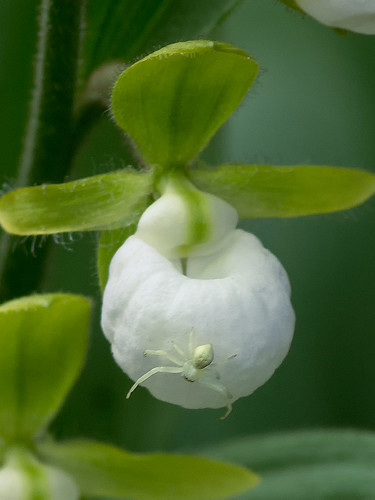The first field trip of the 2013 Native Orchid Conference symposium was at Caribou Road in Plumas County, California. Our group caravan of four vehicles met near the little village of Belden (actually merely a crossroads with a store and post office) to plan the day’s activities. Soon, we were on our way.
Our first stop was at a small creek/seep just into the woods beside the road. Our fearless leader, Raymond Prothero, a native of Sacramento and one of the field trip coordinators, led us into the woods while explaining what we were about to see. We had no sooner gotten to a large fallen tree, when we saw hundreds of tiny white flowers — our first orchid of the day, Cypripedium californicum or California Lady’s-slipper orchid:
Here is a close-up shot of the flowers of Cypripedium californicum:

As we scrambled to position ourselves to photograph this wonderful little orchid, there were many exclamations of “Wow!” and “Can you believe that!”. Although I had seen this species on a previous NOC field trip in northern California a few years prior to this trip, I was still amazed at how pretty this orchid species really is.
One of the group noticed a small spider on one of the pouches of the orchid, and soon the photographers were busy capturing it on “film”. This was only the first of several of the tiny crab spiders we would see at this site:

 |
 |
As a side note, I will add that these tiny crab spiders always tend to mimic the color of the plant they choose as their host. That is the way in which they camouflage themselves from their prey. I’ve seen yellow ones on Yellow Lady’s-slipper orchids in North Carolina and pinkish ones on Showy Lady’s-slipper orchids in Manitoba, Canada. Apparently it is the same species, and it is able to change color to match its host flower after about ten to twenty days of being on the orchid. How amazing is that adaptation? According to scientists who have studied this spider, the color change is induced by visual feedback; spiders with painted eyes were found to have lost this ability to change color. Incidentally, even though this spider is very small, it is ferocious and quick on the draw. It is hard for me to believe how quickly it can grab a prey insect that is many times larger than the spider, itself.
Here are a couple more images of the Cypripedium californicum plants:
 |
 |
As you can see, the flowers are located at each bract along the stem. These bracts actually look like small leaves, but the leaves are farther down on the stem, below where the flowers appear. As I mentioned earlier, there can be as many as twenty of these tiny (less than 1 inch or 2.5 cm) flowers on each flower stem. That is certainly quite a sight to see in the woods.
Here is a shot of Raymond as he is pointing out other neat plants in the immediate area. Notice the orange lilies in the background. More about this, later:

He is crossing over a fallen tree, beside which were many hundreds of California Lady’s-slipper orchid flowers:
 |
 |
I’ve been told that I don’t include enough shots of people at these events, so here are a couple of shots of some of the field-trippers in our group discussing things botanical and admiring the large number of orchid plants in the immediate area:
 |
 |
Well, here is that Lilium pardalinum or Leopard Lily I mentioned earlier:
 |
 |
It’s really bright and pretty and reminds me a lot of our East Coast’s Turk’s-cap Lily with its multiple-flowered stems. Again, we saw it in a number of other wet sites that day and also the next field trip day.
We finished our photography, loaded our gear, and prepared to travel on down the road to another orchid site, this time for Epipactis gigantea or Stream orchid, but I’ll save that for tomorrow’s blog post…
— Jim


0 Responses
The relationship of the crab spider with the Cyps is fascinating. They sometimes “guard” the entrance to the pollinium and nab the pollinator for dinner. How cool is the color change! Lovely, lovely photos and info. Hope your friends like seeing their photos in your blog.
My field trip articles never have people. I am always shooting flora 🙂
Walter got a great shot of that spider spanning the opening in the pouch as you described. By the time it was my turn to photograph it, the spider had moved to the side of the pouch… 🙁
Another great report! Those Cyps are amazing. On a non-orchid note, that Leopard Lily macro is fantastic.
On a semi-orchid note, the crab-spider paragraph was interesting and the comment about their coloration mimicking their host is spot on! Had to go back and look at my pictures and, yup, it’s true. Here’s a crab spider on a Cleistes taken a while back: http://www.flickr.com/photos/skipp35/4651202593/ Definitely tinted to match the host.